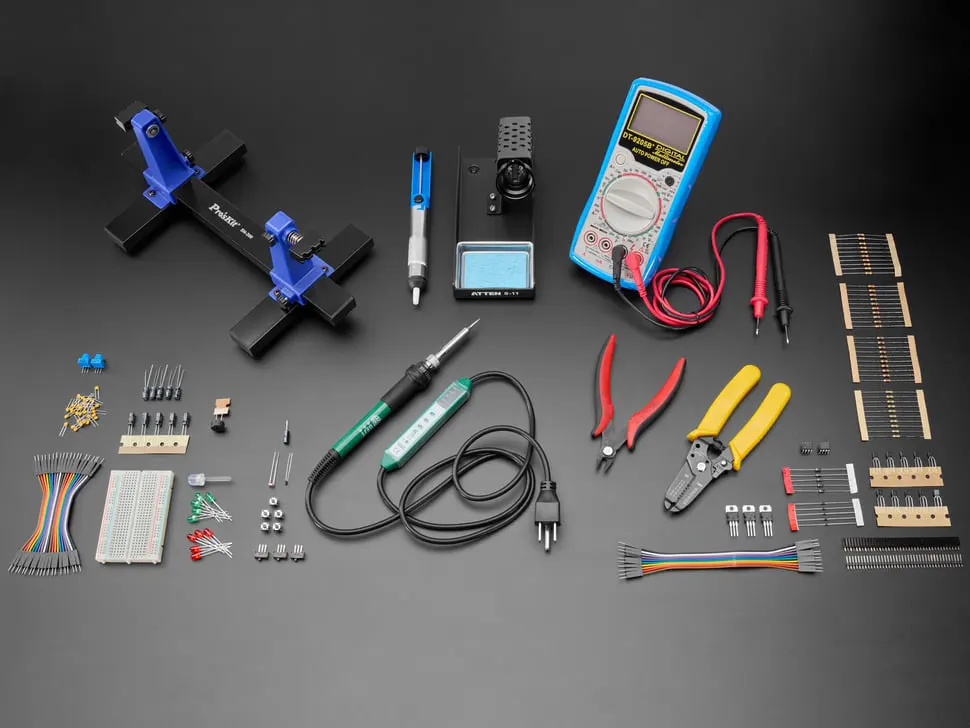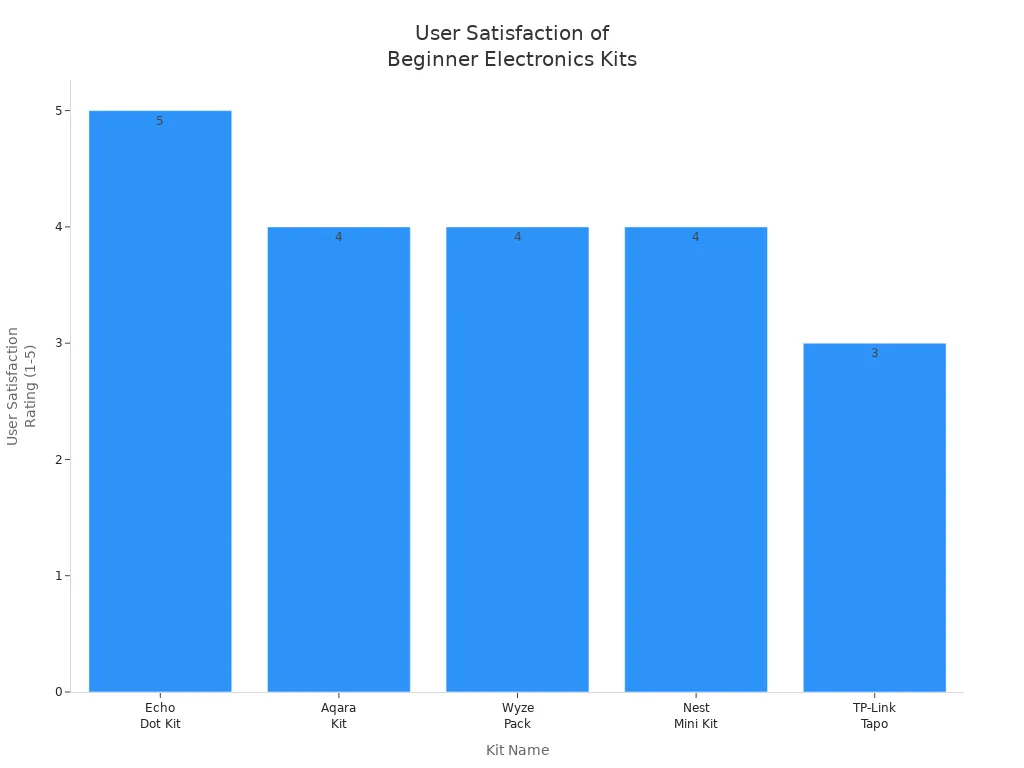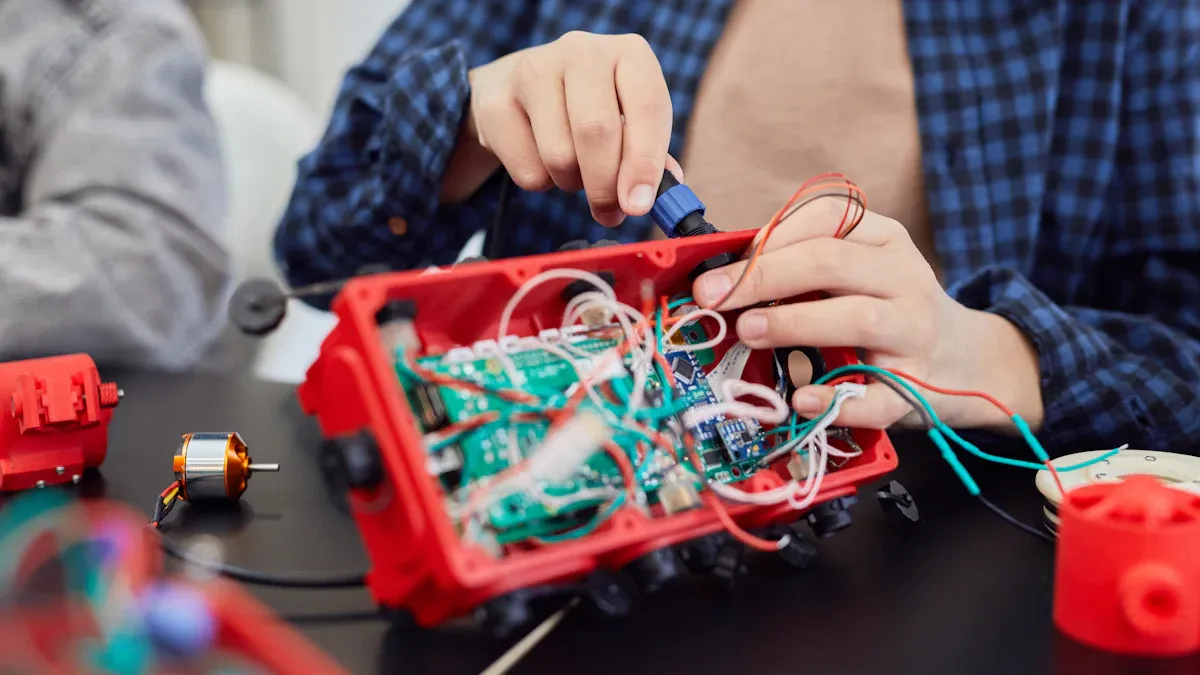
Electronics kits help you learn how things work. They come in many types. Each kit has a special purpose. Some people want to build robots. Others like to make lights blink or sounds play. Here are some types you can find today:
-
Arduino kits
-
Raspberry Pi kits
-
Robotics kits
-
LED kits
-
Audio kits
-
Power supply kits
-
Assorted component kits
Kids and adults can both use beginner electronics kits. You can pick a kit that matches your interests and skills. The right kit makes learning STEM fun and exciting. Think about what you want to try. You might like coding, robotics, soldering, music, or simple circuits. Decide before you start.
Key Takeaways
- Beginner electronics kits come in many kinds. Some are Arduino, Snap Circuits, and robotics kits. Each kit fits different interests and skills. Most kits are safe for kids who are 8 or older. Kits for younger kids have easy snap-together parts. Older beginners can try kits with soldering or coding. Good kits have clear instructions and hands-on projects. They have parts that help you learn coding, circuits, and hardware. You learn these skills step by step. You should pick a kit based on your age and interests. Your learning style and budget also matter. Picking the right kit makes learning fun. It helps you feel more confident. Many kits have strong community support and tutorials. This makes it easy to get help. You can keep growing your electronics skills.
Best Electronics Kits for Beginners
Top Picks
Picking the right electronics kits makes learning simple and fun. Here are the top 10 choices for 2025. These help beginners try circuits, coding, and diy projects:
-
Arduino Starter Kit
This kit helps people learn about microcontrollers and coding. It has an Arduino board, sensors, LEDs, resistors, and a project book. You can make things like a digital thermometer or a game. The kit is good for ages 12 and older. -
Snap Circuits Jr.
Snap Circuits Jr. uses parts that snap together. You do not need to solder. It has over 30 parts and instructions for more than 100 projects. Kids as young as 8 can build alarms, lights, and fans. -
SmartLab Smart Circuits
This electronics diy kit has plug-and-play wiring and snap boards. It comes with 49 parts and a science activity book. Kids ages 8 and up can make games, sensors, and sound machines. -
Makeblock mBot Coding Robot Kit
The mBot is a robot that teaches coding and robotics. It has motors, sensors, and a remote. You can program it with block coding or Arduino language. It is best for ages 10 and up. -
Velleman MK171 Voice Changer Kit
This electronics diy kit lets you build a voice changer. It comes with a circuit board, microphone, and speaker. You need to solder, so it is for teens and adults ages 14 and up. -
Elenco SP-1A Soldering Kit
This kit helps beginners learn how to solder. It has a practice board and basic parts. It is great for ages 12 and up who want to learn hardware skills. -
Jameco KitPro Vein Finder Kit
This special electronics exploration kit helps you build a device that finds veins with infrared light. It has all the parts and instructions you need. It is best for teens and adults who like medical technology. -
Velleman MK102 Flashing LED Kit
This kit teaches you how to make LEDs flash in patterns. It has a circuit board, LEDs, and resistors. You need to solder, so it is for ages 12 and up. -
Velleman MK103 Sound to Light Kit
This electronics exploration kit lets you build a circuit that turns sound into light. It has a microphone, LEDs, and a board. Teens and adults ages 12 and up can learn about sound sensors and soldering. -
Elegoo Uno Kit
The Elegoo Uno kit is like the Arduino Starter Kit but costs less. It has an Uno board, sensors, motors, and a guidebook. It is perfect for ages 12 and up who want to try coding and hardware projects.
Tip: The Insignia™ Everyday Adventures Accessory Kit is also a good choice for beginners. People like it because it is a good value, has many parts, and is easy to use.
Key Features
The best electronics kits for beginners have some important things in common:
| Feature Category | Description |
|---|---|
| Age Suitability | Most kits are safe for kids ages 8 and up. |
| Build Time | Projects can be finished in 30 minutes or a few hours. |
| Instructions | Kits come with clear, step-by-step guides. |
| Assembly Method | Many kits use snap-together parts or easy soldering. |
| Project Variety | Kits let you do many projects, from simple circuits to robots. |
| Continued Learning | Some kits teach coding or have tutorials for harder projects. |
| Educational Design | Color-coded parts and safe assembly help you learn and stay safe. |
| Learning Approach | Building with your hands helps you see how things work. |
| Kit Diversity | There are kits for robotics, music, coding, and more. |
Many kits, like Snap Circuits and SmartLab Smart Circuits, use snap-together parts. Others, like the Arduino Starter Kit and Elegoo Uno Kit, focus on programming and hardware. Kits such as the Elenco SP-1A Soldering Kit help you practice soldering. The Makeblock mBot and Velleman kits have special projects, like building robots or sound-to-light circuits.
Suitability by Age
| Electronics Kit | Recommended Age Range |
|---|---|
| Snap Circuits Jr. | 8+ |
| SmartLab Smart Circuits | 8+ |
| Makeblock mBot Coding Robot Kit | 10+ |
| Arduino Starter Kit | 12+ |
| Elegoo Uno Kit | 12+ |
| Elenco SP-1A Soldering Kit | 12+ |
| Velleman MK102/MK103 Kits | 12+ |
| Velleman MK171 Voice Changer Kit | 14+ |
| Jameco KitPro Vein Finder Kit | 14+ |
Most beginner electronics kits start at age 8. Kits that need soldering or coding are usually for ages 12 and up. Teens and adults can try harder kits, like the Arduino Starter Kit or Jameco KitPro Vein Finder Kit.
Standout Benefits
-
Tutorials are easy to follow and show each step.
-
Hands-on learning keeps you interested and helps you remember.
-
Kits teach coding, robotics, and automation in a simple way.
-
You learn hardware skills, like soldering and building circuits.
-
Kits explain basic electronics, like circuits, sensors, and radio frequencies.
-
Many kits let you build real things, like robots or home gadgets.
-
Open-source platforms like Arduino have strong community support.
-
Kits are not expensive, with prices from $15 to $90.88.
-
Fun projects keep you excited and interested in STEM.

Many people start with simple kits, like Snap Circuits. Later, they try harder kits, such as Arduino or Elegoo Uno. Breadboards and microcontrollers help you try bigger projects. Many electronics kits for beginners have both hardware and programming, so you can keep learning as you grow.
Note: Brands like Arduino, CircuitMess, and Makeblock are known for good kits and strong learning support. Kits from these brands often have detailed guides and active online groups.
Electronics Component Kits Overview

What’s Included
A good component kit gives beginners what they need to start. Most kits have many parts for trying out circuits and diy projects. Here is a quick look at what you usually get:
| Component Type | Description |
|---|---|
| Resistors | Control current flow in circuits |
| Capacitors | Store and release electrical energy |
| LEDs | Light up in different colors |
| Transistors | Switch or amplify signals |
| Diodes | Let current flow in one direction |
| Switches & Pushbuttons | Turn circuits on or off |
| Potentiometers & Trim Pots | Adjust resistance for tuning |
| Inductors | Store energy in a magnetic field |
| Oscillators | Create repeating signals |
| Buzzers | Make sounds |
| Connecting Wires | Link parts together |
| Terminals | Connect to breadboards easily |
| Breadboards | Build circuits without soldering |
| Power Supplies | Provide energy for projects |
| Integrated Circuits | Chips like timers or amplifiers |
| Prototype PCBs/Veroboards | For permanent soldered circuits |
| Component Testers | Check if parts work (in some kits) |
| Multimeter | Measure voltage and current (sometimes) |
Many kits also have microcontrollers, like arduino boards, for harder diy projects.
Learning Focus
Electronics component kits help you learn by building things. You put hardware together and also write code to control it. Some kits are about building, while others focus on coding. For example, arduino kits let you make circuits and then program them to blink lights or move motors. Modular kits let you take things apart and try new designs.
Tip: Pick kits with clear, step-by-step guides. These guides often have pictures, safety tips, help for problems, and even video links. This support makes learning diy electronics easier and more fun.
Hands-On Experience
Hands-on learning is the main part of these kits. When you build circuits, you get better at solving problems and feel more confident. You learn to connect wires, use breadboards, and test your ideas. Many kits let you be creative and design your own projects after you finish the basics. This way, you learn both the ideas and how electronics work in real life.
-
Electronics component kits give you all the parts and instructions for projects, from easy LED circuits to harder systems.
-
You learn real skills in coding, building circuits, and fixing problems.
-
Hands-on learning keeps you interested and helps you remember things.
-
Many parents and teachers see that students like STEM more after using these kits.
Electronics component kits work for many ages and skill levels. They help you build a strong base for future technology and engineering work.
How to Choose the Best Electronics Kits
Age and Skill Level
Choosing the right diy electronics kit starts with age and skill level. Kids ages 8 to 12 often do best with kits that use snap-together parts or simple plug-and-play boards. Teens and adults can try kits that need coding or soldering. Some brands, like CircuitMess and KiwiCo, design kits for different age groups. For example, a 7-year-old might enjoy a hands-on Batmobile project, while a teen could build a remote-controlled car or even a video game console. The table below shows how some popular brands match kits to age groups:
| Age Group | CircuitMess Example | KiwiCo Example | Creation Crate Example |
|---|---|---|---|
| 5-8 | DIY Batmobile | Kiwi Crate | Entry-level kits |
| 9-12 | Wacky Robots, STEM Box | Tinker Crate | Engineering kits |
| 13+ | Advanced STEM Box | Maker/Eureka Crate | Advanced electronics kits |
Interests and Goals
Everyone has different interests. Some want to build robots, while others like music or lights. A diy soldering kit helps those who want to learn hardware skills. Kits with microcontrollers, like Arduino, are great for kids who want to code. Others may want to make sound machines or light shows. Before picking a kit, think about what you want to learn. Do you want to build projects, learn programming, or just have fun with simple circuits? Many kits let you start with basics and move to harder projects as you grow.
-
Choose kits with well-known parts like resistors, LEDs, and buzzers.
-
Look for kits that match your learning goals, such as building, coding, or making music.
-
Pick kits with good instructions and quality materials.
Learning Style
People learn in different ways. Some like to see how things work, while others want to build with their hands. Visual learners enjoy kits that show how electricity moves with lights or sounds. Hands-on learners like to snap parts together or use breadboards. Theoretical learners want to know why things work, so they need kits that explain the science. Many diy kits mix these styles, using pictures, step-by-step guides, and real projects to help everyone learn.
Tip: Kits like Snap Circuits and littleBits are great for hands-on and visual learners. They make learning fun and easy to understand.
Budget Considerations
Price matters when picking a kit. Some basic kits cost as little as $15, while advanced robotics kits can go up to $399. Most starter kits fall between $50 and $90. A higher price often means more parts, better instructions, or extra features like coding. For example, the Snap Circuits Project Kit costs about $89.99 and lets you build over 300 projects. Always check what comes in the box. Some kits need extra tools or batteries.
| Price Range | Example Kits | Features Included |
|---|---|---|
| $15-$18 | micro:bit, KidzLabs Hand | Basic parts, no motors or batteries |
| $50-$90 | Smart Circuits, Arduino Kit | More parts, guided projects, coding |
| $90-$399 | Makeblock mBot | Robotics, coding, advanced accessories |
Parents and beginners should read reviews, watch YouTube videos, and ask for advice in forums. Look for kits with clear guides and strong community support. Pick a kit that matches your age, interests, and budget for the best learning experience.
Picking the right electronics kit helps you stay excited about learning. Good kits fit your skill level and have hands-on projects. They also come with easy-to-follow instructions. Many people start with Arduino or Snap Circuits. These kits help you feel confident and make you want to learn more.
-
Choose kits that are easy to use and have good guides.
-
Read reviews and check online groups before you buy.
-
Pick projects that match what you like for more fun.
Anyone can begin learning electronics now. The right kit lets you be creative, solve problems, and have fun! 🚀
FAQ
What is the best electronics kit for absolute beginners?
Snap Circuits Jr. works great for beginners. It uses snap-together parts, so no soldering is needed. Kids and adults can build simple projects and see results fast. The instructions are easy to follow.
Do I need to know how to code before starting with these kits?
No coding experience is needed for most beginner kits. Kits like Snap Circuits or SmartLab Smart Circuits focus on hardware. Kits with coding, like Arduino, include step-by-step guides for beginners.
Can adults use beginner electronics kits?
Yes! Many adults start with beginner kits to learn the basics. Kits like Arduino Starter Kit or Elegoo Uno Kit work well for teens and adults. These kits help users build skills before moving to advanced projects.
Are these kits safe for kids?
Most kits for ages 8 and up use safe, low-voltage parts. Kits that need soldering should have adult supervision. Always check the recommended age and safety tips in the instructions.
What if I get stuck on a project?
Many kits include troubleshooting tips in the guide. Users can also find help in online forums or watch tutorial videos. > Tip: Search for the kit name on YouTube for step-by-step help!
Written by Jack Elliott from AIChipLink.
AIChipLink, one of the fastest-growing global independent electronic components distributors in the world, offers millions of products from thousands of manufacturers, and many of our in-stock parts is available to ship same day.
We mainly source and distribute integrated circuit (IC) products of brands such as Broadcom, Microchip, Texas Instruments, Infineon, NXP, Analog Devices, Qualcomm, Intel, etc., which are widely used in communication & network, telecom, industrial control, new energy and automotive electronics.
Empowered by AI, Linked to the Future. Get started on AIChipLink.com and submit your RFQ online today!




